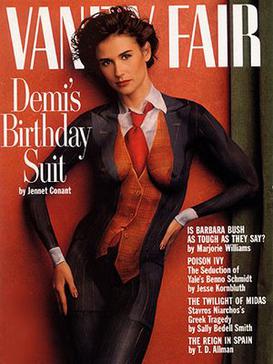Reading Demi Moore’s memoir Inside Out is like having a seat in the room while she is undergoing therapy. And yoga. And flirting with Bruce Willis. And being abused by her parents. And, strangest of all, not spending much time in Hollywood. But you do get a pretty good picture of her home and life in Hailey, Idaho, which she clearly loves, an oasis she has created for her family and herself.

Inside Out flows, but it is not exactly an easy book to read. Real pain and trauma is spread throughout its pages. Moore had an extremely difficult childhood, raised by parents (mostly her mother) who at best ignored her, at worst practically pimped her out as a young girl. It is amazing to think how far she has come, considering her rough start. Moore is unflinchingly honest in her revelations and discoveries about her family’s and her own weaknesses. She tends to downplay her own achievements, certainly as an actress, so it is hard for the reader who might want to learn some more details behind how she got her role in Ghost as much as how Joel Schumacher helped her kick her booze and cocaine habit during the filming of St. Elmo’s Fire. She was successful at both, and stayed sober for years. Her substance abuse issues would crop up again later in her life, in her 40s, when she was married to Ashton Kutcher, who apparently enabled bad choices and then chose to look away when things got to be too much for her to handle.
Where Moore allows herself to feel proud of herself and crow a bit are when she talks about her love of being pregnant, a mother, and her love for her daughters. She also toots her own horn a little when she discusses her iconic Vanity Fair (August 1991) cover shoot by Annie Liebovitz, taken when she was seven months pregnant. The cover was quite controversial at the time, and paved the way for women to celebrate their “baby bumps” – wearing more form-conscious fashion, something we take for granted now. Moore also was one of the first actresses to earn $10 million for a single film in Hollywood. She starred in numerous blockbusters in the 90s: Ghost, A Few Good Men, Indecent Proposal, Disclosure, as well as producing If These Walls Could Talk and the Austin Powers movies.

She appeared nude again for Vanity Fair, photographed by Liebovitz, covered in body paint, a year later. The photo was a testament to bouncing back from pregnancy weight as well as highlighting Moore’s intense workout regimen, which was highlighted throughout her movie career, most notably in G.I. Jane and Striptease. Moore describes herself as an obsessive personality, who has not just battled drugs and an eating disorder, but also working out too much, to the point of making herself ill. It is hard to determine how much Hollywood’s fixation with women’s bodies and her own trauma from childhood sexual abuse played a part in her feelings about herself and her body. But she is not afraid to ask the question or try to find the answer.
What might have been the most gossipy part of the book – her relationships with high-profile men like Emilio Estevez, Bruce Willis, and Ashton Kutcher – are less about fun times than highlighting her or their inability to connect. At the end of Inside Out I don’t feel sorry for Moore, but I do feel empathy. And maybe a little hope, as she continues on her path to self-discovery.
This review first appeared on Cannonball Read 11
This review first appeared on Cannonball Read 11

0 comments:
Post a Comment